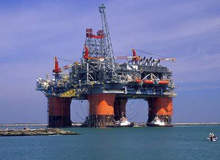
Look at any industry forecast on the growth of investment in floating production systems (FPS) and it soon becomes clear that rapid growth is expected over the next decade and beyond.
Sustained high oil prices, growing global energy demand and the need to extend the reach of exploration and production (E&P) are driving this investment, which is targeted not only towards building new vessels and platforms, but also enhancing the capability of their component technology.
submersible platforms are again becoming a popular choice for ultra-deepwater fields.”
FPS FACILITIES
FPS facilities are growing in number around the world, notably in Asia, West Africa, Brazil and the Gulf of Mexico, in all their forms, with more sophisticated designs for semi-submersible platforms, tension leg platforms, spar platforms, production barges and floating production storage and offloading (FPSO) vessels continuing to emerge as operators look to improve efficiency, flexibility and capacity.
There are, by some estimates, over 100 projects in the planning stage that may well require FPS technology in the future, and orders for these systems are backing up.
The most common floating systems are FPSOs, which continue to attract significant investment, as producers aim to leverage the value of a system that offers storage and some production capability, as well as being especially effective in remote and deepwater operations. Their value in unlocking smaller fields, that would not be economically viable if a more expensive platform were to be built, is a major attraction.
STREAMLINING OIL PRODUCTION
Taking some processes off the platform an FPSO serves and putting it on the vessel enables a leaner platform, so there is a strong drive to improve the sophistication of the on-board production capabilities. For technology developers, the goal is to increase the capability of FPSOs by allowing them to carry more sophisticated and compact systems, and there is a positive outlook to their efforts.
"We are very excited about the floating production market," said Jesus Pacheco, executive VP for new equipment worldwide at Dresser-Rand, commenting on the firm's deal to supply Total with advanced FPSO turbomachinery for a vessel in the Pazflor Field, offshore from Angola.
The $44m deal for gas compression systems will see two gas-turbine and two electric-motor centrifugal-compression trains.
"Our technology adds value to Total by reducing the weight and footprint of the compression system, as fewer casings are required. It also maximises gas throughput compared to competitor offerings as a result of the high efficiency of the compressors. We believe activity in the floating production market will continue to be significant," he added.
Further innovation is taking place in FPSO data management systems. The huge Chevron FPSO vessel newly arrived at the Agbami field offshore from Nigeria in January, which can store 2.2 million barrels of oil and which is set to pump up to 250,000bpd from the field, includes the Aveva Net Portal, which will manage the critical data from the field's operation as the vessel produces oil and pumps back water and gas to manage reservoir pressure.
Other key areas of FPSO technology development include environmental protection technology, but it should be noted that FPSOs are not always seen as the answer to deepwater operations, and future system development may, in fact, see producers favour subsea technology for some applications.
Last summer, Shell opted for subsea pipelines for its Perdido field development, rather than FPSO. Had it chosen FPSO, it would have been the first such system in the Gulf of Mexico, but the pipeline approach was chosen despite the ultra-deepwater nature of the reserve. Shell is pursuing the concept that systems on the seafloor could reduce the need for offshore platforms, and its Ormen Lange gas field joint venture in Norway, where it is looking to install compressors on the sea floor, is
another case in point.
BIGGER, BETTER FLOATING PLATFORMS
Innovation continues to push forward the capabilities of the various designs for floating platforms in deepwater environments. Semi-submersible platforms are once again becoming a popular choice for ultra-deepwater fields or operations that coordinate numerous wells spread over a wide area.
BP's Thunder Horse platform in the Gulf of Mexico, for instance, will produce 250,000 barrels of oil and 200 million cubic feet of natural gas daily, and will be the Gulf's largest producer when it begins production – BP hopes at the end of 2008. It has a network of 25 subsea wells, and is, so far, the largest production semi-submersible platform.
Atlantis is another of BP's fields where it is pushing the capabilities of floating technology. The semi-submersible platform handles 18 wells, and is the deepest moored one of such platforms, operating as it does in over 7,000ft of water.
"The water depths and reservoir structure make Atlantis one of the most technologically challenging developments undertaken by BP," said Andy Inglis of BP's E&P department at the commissioning of Atlantis platform.
Atlantis has added new technology, including deepwater ocean bottom nodes seismic acquisition (OBS) – an innovative new type of seismic sensor designed to work on the seabed in deepwater locations – it has supported the industry's largest and deepest OBS survey.
More generally, the industry continues to look at improving the capability of light deckload production semi-submersible platforms to improve their performance in ultra-deepwater locations, just as it continues to develop mini-tension leg platforms (TLP), though these are less appropriate for the deeper fields and impose relatively low limits on storage.
Of greater depth potential are spar platforms, which are also drawing investment. At Shell's Perdido project, for instance, a new system will cluster numerous wells on the seafloor and connect them to a spar platform – the deepest spar production platform in the world. Once again, light deckload platforms are very much a focus for the future in terms of spar design.
It appears that the pace of growth in sophistication of FPS technology is matched only by the industry's investment in these systems.



